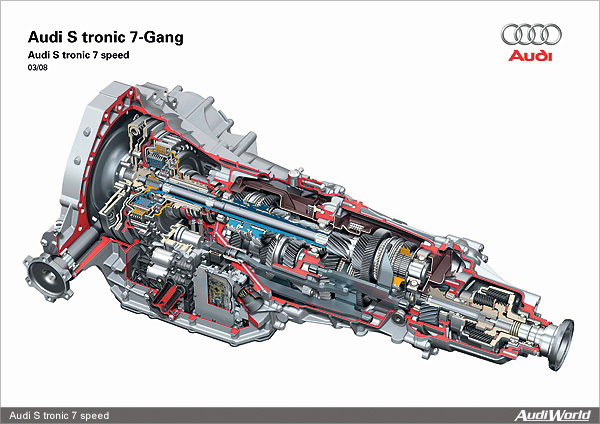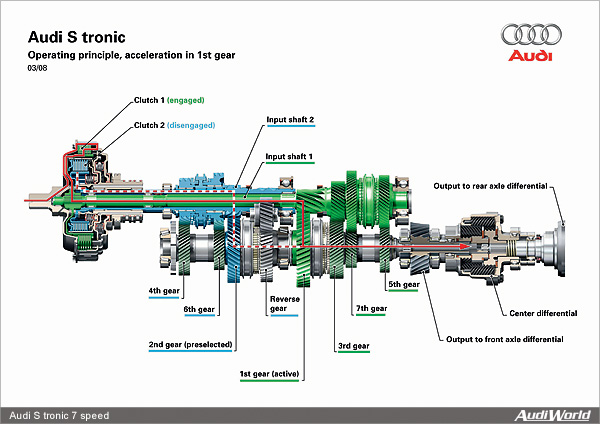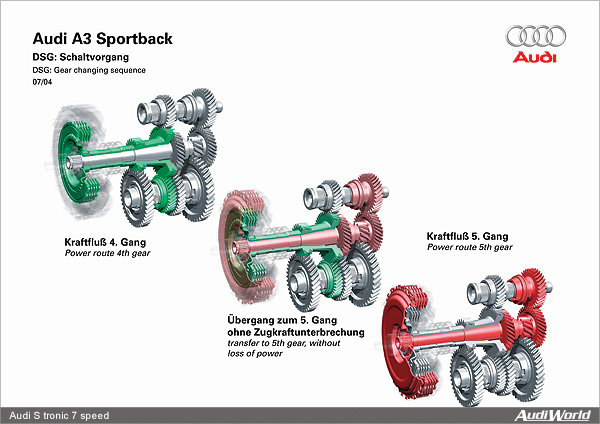The New Audi S tronic: Seven Gears for Dynamics and Efficiency

Seven gears that shift at lightning speed without interrupting traction Audi presents a new phase in the evolution of transmission systems. The seven-speed S tronic combines its dynamic working method with high efficiency. The new twin-clutch transmission is designed to work with longitudinally installed engines and the quattro all-wheel drive system, and its 550 Nm torque capacity makes it suitable for a wide range of sporty models. Audi will introduce the new S tronic into multiple model lines in series production during the course of this year. With the seven-speed S tronic, Audi is launching a new phase in its drive strategy. The new transmission, which was developed entirely by Audi, is intended for the mid-range model lines. Audi has designed it to be sporty while also being a highly efficient high-tech component. Audi drivers can use the new seven-speed S tronic in various modes. The fully automatic mode, in which the computer selects the gear, keeps the D (Drive) and S (Sport) programs available. The gears can also be manually switched with the shift selector lever or with the optional rocker switch on the steering wheel an amazingly fast process. The new high-tech transmission from Audi gives the driver a dynamic and comfortable sense of shifting with unsurpassed precision and perfection. It combines outstanding economy with superb agility and potential for sporty driving. The seven-speed S tronic is composed of two transmission structures. It integrates two multidisk clutches that control different gears. The large K1 clutch located on the outside conducts the torque via a solid shaft to the gear wheels for the odd gears 1, 3, 5 and 7. They are located in the rear of the cast-aluminum transmission housing, toward the center of the vehicle. A hollow shaft rotates around the solid shaft. It is connected to the smaller K2 clutch, which is integrated into the inside of its larger sibling, and which controls the gear wheels for the even gears 2, 4 and 6, as well as reverse gear. All gear wheels are located in a single row on both drive shafts, in the order 4, 6, 2, R, 1, 3, 7 and 5. Both transmission structures are continuously active, but only one is powered at a time by the engine. For example, when the driver accelerates in third gear, the fourth gear is already engaged in the second transmission structure lying in wait, so to speak. The switching process takes place as the clutch shifts while K1 is opening, K2 closes at lightning speed. This process takes only a few hundredths of a second and is completed without interrupting traction. It is so comfortable and smooth that the driver hardly notices it. The power flows from the drive shaft to the self-locking center differential of the quattro drivetrain, which distributes it into two directions. In the basic distribution, 60 percent of the torque flows over the cardan shaft to the differential for the rear axle, and 40 percent flows over a side shaft to the bevel gear of the front-axle differential. Because this shaft is installed at a 7.2 degree angle, it uses a slanted, beveloid gear. To reduce weight, it is also hollow. The asymmetric-dynamic power distribution provides sporty and agile driving characteristics with slight emphasis on the rear end. When needed, the center differential can deliver up to 85 percent of the power to the rear axle or a maximum of 65 percent of the power to the front axle.
Typical Audi: uncompromising quality Each component of the new seven-gear S tronic attests to Audis innovative way of thinking and to the companys uncompromising quality standards. Carbon-coated synchronizer rings ensure synchronization of unsurpassed quality and stability. The gears one through three and reverse are also designed as three-cone synchronizations. Highly precise management of both multidisk clutches was one of the most important development goals. This was achieved in part with a compact pressure cylinder, electronically controlled rotation speed compensation and the use of an optimized coil spring package. This package of technology provides maximum precision and comfort at startup and shifting. The transmission is managed by the so-called mechatronic module. This module involves a compact group of control units and hydraulic control valves that is integrated on the left of the transmission when facing the direction of travel. Its control concept allows the speed of the gear shifting process to vary and extremely precise control of the power necessary for the process. The required control pressure is provided by an efficiently operating oil pump that is located next to the mechatronic module and is driven by a gear section. The oil pump is supported by a vacuum booster for cooling the twin clutch during starting. This allows the amount of oil pumped to be roughly doubled as needed without increasing power. A unique feature of the seven-speed S tronic is its two separate oil systems. While the twin clutch, mechatronic module and oil pump are supplied by their own oil circuit with seven liters of automatic transmission fluid (ATF) oil, the wheelsets and the central and front-axle differential are lubricated with about 4.5 liters of hypoid gear oil. This separation allowed the development engineers to position all of the components ideally, without being forced to compromise by using a single lubricant. Audi has designed the new seven-gear S tronic to provide both exhilarating driving and consistent economy. The new high-tech engine is notable for its very high efficiency. Its highly intelligent controls also allow economical driving in automatic mode. The maximum possible transmission-ratio spread of 8.0:1 allows a sporty, short transmission ratio for the first gear as well as an rpm-sinking, long ratio for the last gear. The seven-speed S tronic is designed for up to 9,000 rpm and can transmit torque of up to 55 Nm. Vorsprung durch Technik: the history of S tronic Audi has led the march in the field of transmissions for many years. The introduction of quattro all-wheel drive in 1980 was a milestone in the history of automotive technology. And the S tronic is a prime example of the company’s basic philosophy Vorsprung durch Technik. The first Audi with a twin-clutch transmission was produced way back in November 1985 the Sport quattro S1, which was driven by Walter Röhrl and his copilot Christian Geistdörfer in the World Rally Championships. Röhrl, the finest rally pilot of his time, described his 350 kW (476 hp) sports car as a formidable thing and a natural phenomenon and the high-tech transmission provided him with even more powerful performance. The twin-clutch transmission, which was controlled electrically with a short touch control lever in the S1, could shift through its five gears at lightning speed. Because the traction was not interrupted, the turbocharger for the five-cylinder engine remained constantly pressurized a bypass in the engines airways supported this effect. A twin-clutch transmission was also on board the S1 during training for Röhrls victorious storming of the peaks during the 1987 Pikes Peak mountain race in Colorado. The S tronic is one of the most versatile solutions in Audi’s range of transmissions. In the spring of 2003, Audi introduced the technology in series production in the TT Coupe and Roadster, combined with the high-torque 3.2-liter V6 with 184 kW (250 hp). The ultra-compact twin-clutch transmission, designed for transverse installation with six gears, was the perfect complement to the powerful engine. TT pilots could use it in automatic mode or shift the gears by hand, either with the short shift selector lever or with rocker switches affixed behind the steering wheel. In the past five years, the new technology in the TT and A3 has become firmly established as dynamic high-tech alternatives to hand-shifting as well as being fully imbued with the positive attributes of a conventional geared automatic transmission. Due to its wide range of strengths, the S tronic is also available in the A3 with a TDI four-cylinder engine. By the end of 2007, Audi had produced 188,338 cars in both model lines with twin-clutch transmissions.
A wide-ranging program: the ideal solution for every need Today, Audi has a wide-ranging portfolio of transmission technology options five technologies with widely varying characteristics may now be selected to perfectly fulfill their specific range of applications. Aside from the sporty S tronic with six and now seven gears, Audi offers a classic manual transmission, an automatic R tronic, the comfortable tiptronic torque-converter transmission, and the versatile, continuously variable multitronic at least two customized solutions are available for each model range. The common denominators among all of these transmissions are compact and light construction, high efficiency, precise functioning in extremely durable quality, and convenient and simple operation. Manual shift transmissions are available in many of the model ranges, from the compact A3 to the A6, along with the TT, the Q7 and the R8; they are suitable for combination with front-wheel and quattro drives. In the A4 and A5 model lines, Audi has introduced a new generation of transmissions that are notable due to modified positioning of the differential and for their greatly reduced internal friction, which further improves efficiency. Most manual transmissions operate with six gears. In the A3 1.9 TDI e and A3 Sportback 1.9 TDI e, five-gear transmissions are used in which the upper gears feature a somewhat longer gear ratio which helps sink consumption on average to an exemplary 4.5 liters of diesel per 100 km (52.27 mpg). The sequential-shift R tronic with six gears is reserved exclusively for the R8; as befits the character of a supercar, the engineers have designed it to be especially dynamic. In the R tronic, hydraulic units manage activation of the gears and clutch, and the drivers commands are transmitted electronically. The tiptronic transmissions from Audi are found in all sedan model lines, from the A3 to the A8, as well as in the high-performance Q7 SUV, in combination with front-wheel or quattro drive. The great strength of this classic torque-converter transmission is in its highly convenient shifting. In order to improve this even further while also improving efficiency, in the latest configuration, engineers have modified the damping system in the torque converter. In addition, gear shifting is completed more swiftly. The redesigned multitronic also features even greater efficiency and dynamics. The continuously variable transmission from Audi combines the advantages of manual gear shifting with the strengths of an automatic. As an especially comfortable driveline, the multitronic available in the A4, A5, A6 and A8 is paired with front-wheel drive. The new seven-gear S tronic developed by Audi, which will be introduced in series production in multiple models during the course of this year, is combined with quattro technology Audi has designed it as a sporty and highly efficient high-tech transmission. |


